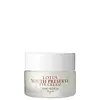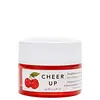What's inside
What's inside
 Key Ingredients
Key Ingredients

 Benefits
Benefits

 Concerns
Concerns

 Ingredients Side-by-side
Ingredients Side-by-side

Water
Skin ConditioningGlycerin
HumectantIsostearyl Isostearate
EmollientPropanediol
SolventSqualane
EmollientCetyl Alcohol
EmollientPotassium Cetyl Phosphate
EmulsifyingPentylene Glycol
Skin ConditioningC10-18 Triglycerides
EmollientBoron Nitride
AbsorbentGlyceryl Stearate
EmollientPolyglycerin-3
HumectantNelumbo Nucifera Extract
Skin ConditioningAesculus Hippocastanum Extract
AntioxidantCitrus Limon Peel Oil
MaskingCucumis Sativus Fruit Extract
EmollientTocopherol
AntioxidantFructose
HumectantEthylene/Acrylic Acid Copolymer
Emulsion StabilisingBis-Diglyceryl Polyacyladipate-2
EmollientBehenyl Alcohol
EmollientDimethicone
EmollientCarbomer
Emulsion StabilisingSodium Polyacrylate
AbsorbentXanthan Gum
EmulsifyingSodium Citrate
BufferingCaprylic/Capric Triglyceride
MaskingSodium Hyaluronate
HumectantCitric Acid
BufferingSodium Hydroxide
BufferingAdenosine
Skin ConditioningBiosaccharide Gum-2
Skin ConditioningSodium Metabisulfite
AntioxidantPoloxamer 338
EmulsifyingSilica
AbrasiveTetrasodium EDTA
Chlorphenesin
AntimicrobialPotassium Sorbate
PreservativeSodium Benzoate
MaskingLimonene
PerfumingCitral
PerfumingWater, Glycerin, Isostearyl Isostearate, Propanediol, Squalane, Cetyl Alcohol, Potassium Cetyl Phosphate, Pentylene Glycol, C10-18 Triglycerides, Boron Nitride, Glyceryl Stearate, Polyglycerin-3, Nelumbo Nucifera Extract, Aesculus Hippocastanum Extract, Citrus Limon Peel Oil, Cucumis Sativus Fruit Extract, Tocopherol, Fructose, Ethylene/Acrylic Acid Copolymer, Bis-Diglyceryl Polyacyladipate-2, Behenyl Alcohol, Dimethicone, Carbomer, Sodium Polyacrylate, Xanthan Gum, Sodium Citrate, Caprylic/Capric Triglyceride, Sodium Hyaluronate, Citric Acid, Sodium Hydroxide, Adenosine, Biosaccharide Gum-2, Sodium Metabisulfite, Poloxamer 338, Silica, Tetrasodium EDTA, Chlorphenesin, Potassium Sorbate, Sodium Benzoate, Limonene, Citral
Water
Skin ConditioningDiisostearyl Malate
EmollientPentaerythrityl Tetraisostearate
EmollientPentylene Glycol
Skin ConditioningAscorbyl Tetraisopalmitate
AntioxidantOrbignya Oleifera Seed Oil
EmollientPhytosterols
Skin ConditioningCaprylic/Capric Triglyceride
Masking3-Glyceryl Ascorbate
AntioxidantGlycerin
HumectantAcrylates/C10-30 Alkyl Acrylate Crosspolymer
Emulsion StabilisingMalpighia Punicifolia Fruit Extract
AntioxidantCaffeine
Skin ConditioningSodium Hyaluronate
HumectantHydrolyzed Sodium Hyaluronate
Skin ConditioningSodium Acetylated Hyaluronate
HumectantSodium Hyaluronate Crosspolymer
HumectantHydrolyzed Plukenetia Volubilis Seed Extract
Emulsion StabilisingLinoleic Acid
CleansingPhospholipids
Skin ConditioningBisabolol
MaskingHelianthus Annuus Extract
EmollientPhysalis Angulata Extract
Skin ProtectingBis-Diglyceryl Polyacyladipate-1
EmollientOryza Sativa Bran Extract
Skin ConditioningTocopherol
AntioxidantHexamidine Diisethionate
EmollientSodium Phytate
Melia Azadirachta Extract
Skin ConditioningMoringa Oleifera Seed Oil
EmollientEthylhexylglycerin
Skin ConditioningPotassium Hydroxide
BufferingRosmarinus Officinalis Leaf Extract
AntimicrobialButylene Glycol
HumectantCitric Acid
BufferingSodium Benzoate
MaskingWater, Diisostearyl Malate, Pentaerythrityl Tetraisostearate, Pentylene Glycol, Ascorbyl Tetraisopalmitate, Orbignya Oleifera Seed Oil, Phytosterols, Caprylic/Capric Triglyceride, 3-Glyceryl Ascorbate, Glycerin, Acrylates/C10-30 Alkyl Acrylate Crosspolymer, Malpighia Punicifolia Fruit Extract, Caffeine, Sodium Hyaluronate, Hydrolyzed Sodium Hyaluronate, Sodium Acetylated Hyaluronate, Sodium Hyaluronate Crosspolymer, Hydrolyzed Plukenetia Volubilis Seed Extract, Linoleic Acid, Phospholipids, Bisabolol, Helianthus Annuus Extract, Physalis Angulata Extract, Bis-Diglyceryl Polyacyladipate-1, Oryza Sativa Bran Extract, Tocopherol, Hexamidine Diisethionate, Sodium Phytate, Melia Azadirachta Extract, Moringa Oleifera Seed Oil, Ethylhexylglycerin, Potassium Hydroxide, Rosmarinus Officinalis Leaf Extract, Butylene Glycol, Citric Acid, Sodium Benzoate
Ingredients Explained
These ingredients are found in both products.
Ingredients higher up in an ingredient list are typically present in a larger amount.
This ingredient is an emollient, solvent, and texture enhancer. It is considered a skin-softener by helping the skin prevent moisture loss.
It helps thicken a product's formula and makes it easier to spread by dissolving clumping compounds.
Caprylic Triglyceride is made by combining glycerin with coconut oil, forming a clear liquid.
While there is an assumption Caprylic Triglyceride can clog pores due to it being derived from coconut oil, there is no research supporting this.
Learn more about Caprylic/Capric TriglycerideCitric Acid is an alpha hydroxy acid (AHA) naturally found in citrus fruits like oranges, lemons, and limes.
Like other AHAs, citric acid can exfoliate skin by breaking down the bonds that hold dead skin cells together. This helps reveal smoother and brighter skin underneath.
However, this exfoliating effect only happens at high concentrations (20%) which can be hard to find in cosmetic products.
Due to this, citric acid is usually included in small amounts as a pH adjuster. This helps keep products slightly more acidic and compatible with skin's natural pH.
In skincare formulas, citric acid can:
While it can provide some skin benefits, research shows lactic acid and glycolic acid are generally more effective and less irritating exfoliants.
Most citric acid used in skincare today is made by fermenting sugars (usually from molasses). This synthetic version is identical to the natural citrus form but easier to stabilize and use in formulations.
Read more about some other popular AHA's here:
Learn more about Citric AcidGlycerin is already naturally found in your skin. It helps moisturize and protect your skin.
A study from 2016 found glycerin to be more effective as a humectant than AHAs and hyaluronic acid.
As a humectant, it helps the skin stay hydrated by pulling moisture to your skin. The low molecular weight of glycerin allows it to pull moisture into the deeper layers of your skin.
Hydrated skin improves your skin barrier; Your skin barrier helps protect against irritants and bacteria.
Glycerin has also been found to have antimicrobial and antiviral properties. Due to these properties, glycerin is often used in wound and burn treatments.
In cosmetics, glycerin is usually derived from plants such as soybean or palm. However, it can also be sourced from animals, such as tallow or animal fat.
This ingredient is organic, colorless, odorless, and non-toxic.
Glycerin is the name for this ingredient in American English. British English uses Glycerol/Glycerine.
Learn more about GlycerinPentylene glycol is typically used within a product to thicken it. It also adds a smooth, soft, and moisturizing feel to the product. It is naturally found in plants such as sugar beets.
The hydrophilic trait of Pentylene Glycol makes it a humectant. As a humectant, Pentylene Glycol helps draw moisture from the air to your skin. This can help keep your skin hydrated.
This property also makes Pentylene Glycol a great texture enhancer. It can also help thicken or stabilize a product.
Pentylene Glycol also acts as a mild preservative and helps to keep a product microbe-free.
Some people may experience mild eye and skin irritation from Pentylene Glycol. We always recommend speaking with a professional about using this ingredient in your routine.
Pentylene Glycol has a low molecular weight and is part of the 1,2-glycol family.
Learn more about Pentylene GlycolSodium Benzoate is a preservative. It's used in both cosmetic and food products to inhibit the growth of mold and bacteria. It is typically produced synthetically.
Both the US FDA and EU Health Committee have approved the use of sodium benzoate. In the US, levels of 0.1% (of the total product) are allowed.
Sodium benzoate works as a preservative by inhibiting the growth of bacteria inside of cells. It prevents the cell from fermenting a type of sugar using an enzyme called phosphofructokinase.
It is the salt of benzoic acid. Foods containing sodium benzoate include soda, salad dressings, condiments, fruit juices, wines, and snack foods.
Studies for using ascorbic acid and sodium benzoate in cosmetics are lacking, especially in skincare routines with multiple steps.
We always recommend speaking with a professional, such as a dermatologist, if you have any concerns.
Learn more about Sodium BenzoateSodium Hyaluronate is hyaluronic acid's salt form. It is commonly derived from the sodium salt of hyaluronic acid.
Like hyaluronic acid, it is great at holding water and acts as a humectant. This makes it a great skin hydrating ingredient.
Sodium Hyaluronate is naturally occurring in our bodies and is mostly found in eye fluid and joints.
These are some other common types of Hyaluronic Acid:
Learn more about Sodium HyaluronateTocopherol (also known as Vitamin E) is a common antioxidant used to help protect the skin from free-radicals and strengthen the skin barrier. It's also fat soluble - this means our skin is great at absorbing it.
Vitamin E also helps keep your natural skin lipids healthy. Your lipid skin barrier naturally consists of lipids, ceramides, and fatty acids. Vitamin E offers extra protection for your skin’s lipid barrier, keeping your skin healthy and nourished.
Another benefit is a bit of UV protection. Vitamin E helps reduce the damage caused by UVB rays. (It should not replace your sunscreen). Combining it with Vitamin C can decrease sunburned cells and hyperpigmentation after UV exposure.
You might have noticed Vitamin E + C often paired together. This is because it is great at stabilizing Vitamin C. Using the two together helps increase the effectiveness of both ingredients.
There are often claims that Vitamin E can reduce/prevent scarring, but these claims haven't been confirmed by scientific research.
Learn more about TocopherolWater. It's the most common cosmetic ingredient of all. You'll usually see it at the top of ingredient lists, meaning that it makes up the largest part of the product.
So why is it so popular? Water most often acts as a solvent - this means that it helps dissolve other ingredients into the formulation.
You'll also recognize water as that liquid we all need to stay alive. If you see this, drink a glass of water. Stay hydrated!
Learn more about Water